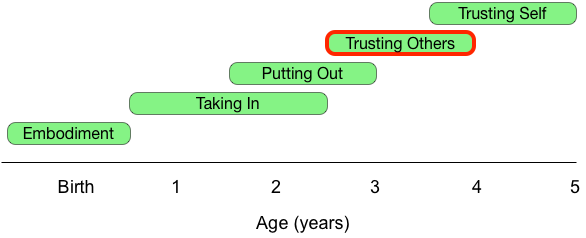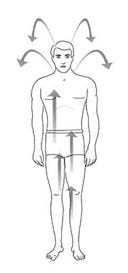[This is part of BFNow Self-Study Module 3: Child Development and Adult Character. For more about the overall Self-Study program, please look at About BFNow Self-Study and BFNow Self-Study Orientation.]
If you haven’t done so already, let me encourage you to pause, relax and release, perhaps with a big stretch or three deep breaths.
The ultimate goal of this lesson is to help you settle into a comfortable sense of support and resiliency via appropriate trust of others and of life. Our pathway to that goal involves
getting an overview of the Trusting Others developmental task and the defensive patterns that emerge when that task gets distorted or blocked
getting a start on healing any underlying wounds.
We will build on this material for the rest of this module and in Modules 4 and 5.
Trusting Others
Timeframe
2.5 to 4 years
Developmental Task
To blend autonomy and connection. To have a separate self and will, yet still be contained and protected in something larger that is benevolent and reliable. Requires caregivers who can continue to expand the child’s sphere of autonomy and action while providing good support and guidance.
When it’s completed well, the child learns that having a separate self and will can be combined with positive social relationships and appropriate continuing-but-diminishing dependency. Life continues to feel safe and worth living. But if the task gets blocked or distorted, the child decides, “I’m on my own.”
Adverse Circumstances and Initial Triggers
There are many experiences that can trigger an I’m on my own decision in the child. Both Kessler and Johnson, as therapists dealing with stronger cases, cite things like a child that gets caught between 1) a parent who is emotionally seductive and heaps praise and attention on the child and 2) the other parent who, in jealousy, humiliates the child. The child eventually understands that they are being used by the first parent for their own narcissistic purposes and likewise can’t count on the second parent for protection. The result is a profound sense of betrayal.
Yet the trigger can be less dramatic. The child gets in a fight with no adults around and realizes they are on their own, at least in that situation. If the child loses the fight, that will tend to enhance any Enduring sub-personality. If the child wins, it strengthens the sense that I can succeed on my own.
The betrayal may come from peers. Children can be quite cruel to each other. If a child feels humiliated by others they may decide I’m never going to let that happen again.
If the child can share these experiences with parents and get helpful guidance and emotionally satisfying support, then the child can keep these experiences in perspective and mature through them. But if the parents aren’t interested or respond in well-meaning but, from the child’s point of view, inadequate or clueless ways, the child can be pushed into a premature and categorical sense of I’m on my own.
Defensive Patterns
Once set, the following beliefs lead to a kind of categorical individualism
I’m on my own
I can win on my own
I’d better not lose because there’s no one to back me up
The child (and eventually the adult) still needs to interact with others, but, with no confidence in the others’ trustworthiness, they turn to domination and control.
I’ll call this a Controlling defense pattern.
There is a powerful feedback loop that can deepen and perpetuate the pattern:
The Controlling one dominates others
Others hold back from honest communications that might upset the Controlling one
Dissatisfactions quietly build in the others until they can’t contain them any more
Others act “all of a sudden” to leave, reject or otherwise challenge the Controlling one
The Controlling one feels betrayed and the pattern is reinforced.
Indicators
How can you tell if one of your sub-personalities has a Controlling defense pattern? Here are some clues. They don’t need to all match or be as stark as I’m describing them. In a Controlling sub-personality:
you are likely to feel: confident, vigilant, powerful, superior, alone, a need to dominate others
you project your energy out around you in an I’m in command way
you fear: betrayal by others; your own needs, which you see as weaknesses; losing; and any dependency on others
under stress you are likely to rely on your will, to attack, to focus outward
you are likely to believe: I can win; Knew I couldn’t trust you; I can handle it; You’re not good enough; There is no protection; Just do it; Rules are for other people
you hold up, your inner critic attacks you with anger and ridicule, and you create what sense of safety you can by amplifying your energy and will and projecting them outward
you’re focused on, and tend to rush into, the future
Positive Aspects
Not all is grim. The defensive pattern itself requires or encourages certain skills and abilities and these can continue to make a positive contribution even after healing the original wounds.
Controlling types learn to be masters of energy and will. They know how to gather them, channel them and get things done. They’re competent and confident, good at attraction and manifestation, courageous and resourceful. They’re natural, charismatic leaders in situations that require heroic leadership. They read others well and are oriented to truth, in the sense of a clear vision of what’s really going on. They’re bold and entrepreneurial, playful and adventurous. As they heal their wounds, they can relax into a deeper connection with life and become even better leaders, teammates and even friends. Kessler identifies Tigger (in Winnie the Pooh) and Lucy (in Peanuts) along with lots of hero types as examples of the Controlling character style.
Historical and Gender Considerations
The Controlling character style is the Empire Era ideal for manhood, which is why it fits the image of an Empire Era hero so well. The Fairy Tale couple is a Controlling style man as hero and a Pulling style woman as damsel in distress. In practice, women can have this defensive pattern as well, although they are more likely to exert control emotionally than physically. Our culture rarely views a Controlling style woman as heroine, although it does happen. Like men hiding their Pulling style in public, women often hide their Controlling style in public yet have Controlling sub-personalities that come to the fore in the privacy of their personal relationships.
Relationship to Other Character Styles
The Controlling style is the Empire Era ideal for parenthood, especially for fathers but also to some degree for mothers. (In the case of parenting, Controlling style = authoritarian.) As we’ve seen, Controlling style parents can give rise to Leaving style and Enduring style children. They also give rise to the defense pattern that comes out of blocking the Trusting Self stage. Their narcissism can prompt a next generation of Controlling style children. So the Controlling style is a keystone part of the replication of the whole Character Styles system.
In hierarchical social systems, it is common for people to relate to their superiors using an Enduring sub-personality and to their inferiors using a Controlling sub-personality. Think of the factory worker who is compliant on the job but is authoritarian and even abusive at home. All too often the accumulated rage in the Enduring sub-personality gets transferred to and through the Controlling sub-personality and the abuse gets passed down the social hierarchy.
Energy Flow
The energy flow in the Controlling pattern is up, into the upper part of the body, and then out over the head down toward others. Have you ever seen animals in a fight where one will stand up and make itself seem even bigger? That’s the feel of the Controlling pattern.
The classic Controlling body type tends to be broad-shouldered and strong, often attractive although somewhat top heavy. The eyes are watchful and can seem compelling and penetrating.
Most of our cultural images for heros and villians correspond to the Controlling pattern. As a society, we have a love/hate relationship with this pattern.
When the Controlling pattern isn’t predominant but just in a particular sub-personality, the body won’t be the Controlling type, but the sense of upward energy and penetrating eyes may well show when the Controlling sub-personality is active.
Alternate Names
The classic name for this character style is Psychopathic. Kessler calls it Aggressive and Johnson calls it the Used Child.
Relationship to Attachment and Pursuit/Withdrawal
While the correspondence is not exact, the Controlling character style connects best to the anxious-resistant/ambivalent attachment style. Here is what we have so far:
In couples, or in any close ongoing dyad, the two partners will often develop a pattern where, under stress, one tends to pursue while the other tends to withdraw. A sub-personality with a Controlling character style would tend toward pursuit when stressed. Here is what we have so far:
As with all of the defense patterns, the key is to build up corrective experiences that give you the skills you missed in childhood and allow you to replace the beliefs that now hold the pattern in place.
With the Controlling pattern, the goal is to connect to something benevolent that can hold and support you so that you no longer feel alone.
Just as with a Chinese Finger Puzzle, you often need to move in the opposite direction from your habitual impulse.
Here are some examples for the Controlling pattern:
Does your internal energy feel mostly in your upper body and head? Practice moving your energy down in your body to create a more balanced overall field. Use the Chest Glow to visualize the glow going into your legs on your outbreath. Practice this enough so that when you get triggered and your energy rises up, you can pause a moment, take a breath and move your energy back down.
Once you feel comfortable in your legs, extend the glow down into the Earth and build/strengthen an energy bridge with the Earth.
Remember all the things in nature that support you: light and warmth from the sun, oxygen and food from plants, rain from the atmosphere, etc.. Allow a feeling of gratitude for that unwavering support from nature.
Adopt a more nuanced understanding of trust. Make it a territory and use a slider. Notice all the people and systems in your life that are mostly reliable, even if they aren’t perfect. (I recommend DeSteno’s The Truth About Trust for a good exploration of the territory.)
Is there any large but taken-for-granted something out there – God, Life, the Universe, etc. – that you feel in some way supports you? Remind yourself daily of that supportive something through images, sayings, meditation, walks in the woods – whatever works for you. Allow yourself to relax into that supportive something.
Experiential
I’m going to recommend two parts to today’s experiential, similar to what we’ve done so far. If anything in this experiential triggers you or feels overwhelming, just stop and get support from people you know.
The first part is about awareness. Starting now and throughout your day, tune into whether you have any sub-personalities with a Controlling character style. Make notes in your journal about what you find. While it may be easier to see some of these character styles in other people, best to understand them in yourself first.Make a rough estimate of the proportion of time you spend in this character style (as a first step toward a pie chart at the end of the module). You can, and likely will, adjust this estimate as the module goes on.
The second part is about healing. In the evening, get into your Optimal Zone adult sub-personality (a few deep breaths can help) and from there connect to one of your Controlling pattern sub-personalities. If you don’t feel you have one (which is entirely possible), still read over the rest of this experiential and imagine, briefly, how you might do it if you did have one.Take some first steps toward developing a partnership in which the Optimal Zone adult can help the younger sub-personality complete the original Trusting Others developmental task. This help, over time, will likely involve:
• reassuring the younger sub-personality that they are no longer under attack or alone; you are here now to protect while they move forward
• asking the younger sub-personality what they need and listening empathetically
• validating that they did the best they could with the resources and skills available at the time
• helping the younger sub-personality shift beliefs toward an appreciation of life’s reliable support.
• building skills and having corrective experiences that bring them comfortably and pleasurably into their own capacity for connection and nuanced trust.For now, just spend some time, in the spirit of the Inner Smile, connecting with the betrayed child at the core of your Controlling style sub-personality. Let it know, as you would with a child, that you are there with respect and support. Listen to what they have to tell you. For now, just be gently with them.
You can take this further if you have the inspiration for what to do – or you can just let this experiential be a seed well-planted for future healing. If you want to really go into this, I recommend at least getting either Schuitemaker’s or Kessler’s book as a guide.
Thanks,
Robert
[Link back to the Module 3: Child Development and Adult Character Overview page.]






